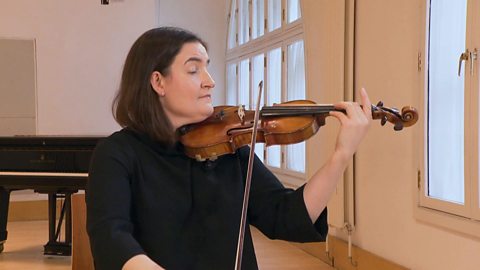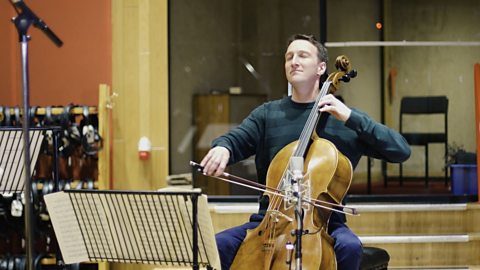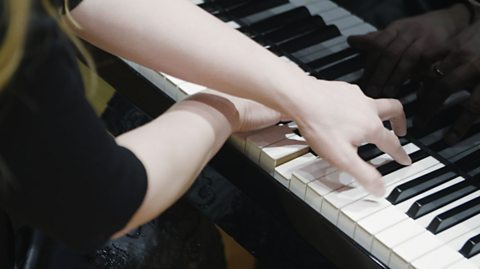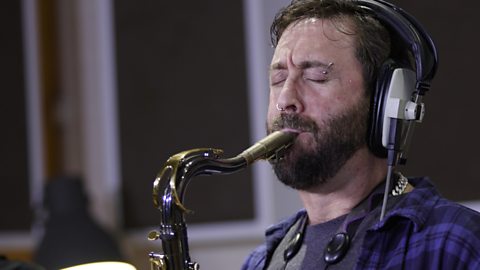Key information
In this article we'll look at the following musical forms that are mandatory concepts in the Higher Music course:
- concerto grosso
- ritornello
- passacaglia
- da capo aria
- sonata form
- through-composed
Baroque forms
Concerto grosso
Concerto grosso is a musical form where contrasting sections are performed by the full orchestra (ripieno) and a small group of soloists (concertino), supported by the basso continuo.
Concerto grosso literally translates as 'big concertoБ─≥ and was common in the first half of the Baroque periodTerm used to describe the period in Western music from around 1600 to 1750..
It eventually made way for the solo concerto which replaced the small group of soloists (concertino) with a solo instrument.
Watch the video below and listen to the ripieno group play ╠А╡╧╡т╩Е╠П╠ТБ─≥s Concerto Grosso in G Major. This is the lively second movement with the tempo marked allegro.
Performers from the ЁихкбшлЁ Scottish Symphony Orchestra play the Ripieno part of ╠А╡╧╡т╩Е╠П╠ТБ─≥s Concerto Grosso in G Major, Second Movement.
Now watch the video below to listen and compare with the concertino or small group of soloists.
In this case, the concertino is a string trio made up of one cello and two violins. Other instruments used in the concertino could include trumpet, flute, oboe, bassoon or recorder.
Performers from the ЁихкбшлЁ Scottish Symphony Orchestra play the Concertino part of ╠А╡╧╡т╩Е╠П╠ТБ─≥s Concerto Grosso in G Major, Second Movement.
Now watch this video of both ripieno and continuo and listen to how the two groups play together.
In addition to the concertino and ripieno was the basso continuo which was a common accompaniment in Baroque music.
This has two parts:
- a bass line played by a low string instrument (usually the cello) along with a harmony (chordal) part
- a harmony or chordal part usually played by a harpsichord
Watch this video and listen to the basso continuo from ╠А╡╧╡т╩Е╠П╠ТБ─≥s Concerto Grosso. Handel writes the bass line for bassoon, double bass and cello while the harpsichord plays the chords.
Listen to any of BachБ─≥s six Brandenburg Concertos to hear the concerto grosso style so common in the early Baroque period.
Ritornello
Ritornello was another form common in the Baroque period:
an Italian word which translates as little return
refers to the main theme which the orchestra plays at the start
this theme will return frequently throughout the music with contrasting music breaking up the structure
similar to a rondo
╠А╡╧╡т╩Е╠П╠ТБ─≥s Concerto Grosso in G Major features this ritornello:
Watch this video and listen again to ╠А╡╧╡т╩Е╠П╠ТБ─≥s Concerto Grosso in G Major.
Notice the ritornello which the piece starts with and listen out as this theme is repeated.
In this clip you can also hear how Handel uses sequences to develop the music. This was a common technique during the Baroque period.
Passacaglia
Passacaglia is another form commonly used during the Baroque period. It was originally a court dance which first appeared in Spain in the 17th Century. The name comes from the Spanish word &#ЁФ27;╠Х╡╧╡У╡У╡╧Ё╕╡╧╠Т╠Т╠ПБ─≥ which translates as Б─≤street songБ─≥.
It has the following key features:
- theme and variations
- features a ground bass
- written in triple time (three beats per bar)
- slow tempo
Below is the ground bass from BachБ─≥s Passacaglia BWV 582. This eight-bar bass line repeats continuously throughout the piece. Notice the anacrusisNote(s) which occur before the first strong beat of a musical bar or phrase used at the start of the music.
Listen to this passacaglia and look out for the following:
- the repeated ground bass as is notated above
- the passacaglia is in 3/4 time
- Bach composed this piece for organ
- the minor tonality?
- the variations above the ground bass which help to sustain the attention of the listener
BachБ─≥s Passacaglia in C minor
Da capo aria
An aria is an opportunity for the solo singer to show off their vocal talents. The de capo aria was common in the Baroque period.
- a vocal style/form based on a poem
- used in both opera and oratorio
- often starts with a ritornello section
- consists of a vocal soloist accompanied by a small baroque orchestra
- Performed in three sections ABA (ternary form) as follows:
- Section A Б─⌠ First stanza from poem set to music
- Section B Б─⌠ Second stanza from poem set to music which is developed and changed
Section B ends with a da capo often shown as D.C. al Fine. Da capo is Italian and literally means to the head or back to the beginning of the music. The word Fine will show at the end of Section A and is an indication to the performer to stop.
- Section A Б─⌠ Repeated first stanza with some small changes Б─⌠ often the singer adds ornaments
Below is the end of Section B in Lascia chБ─≥io Pianga by Handel.
You can see the instruction D.C. (Da Capo) al Fine. This takes the performer back to the Б─≤headБ─≥ or start of the music.
Listen to Lascia ChБ─≥io Pianga from ╠А╡╧╡т╩Е╠П╠ТБ─≥s Opera called Rinaldo while following the score to help guide your listening.
'Lascio ChБ─≥io Pianga' translates as Б─≤Let me WeepБ─≥.
Opening of section A
The end of the section B
Sonata form
Sonata was a popular form used in the Classical Period.
The structure contains three main sections:
- exposition - made up of a first subject, bridge and second subject
- development - in which themes are varied and reworked
- recapitulation - a return to the first subject, bridge and second subject before finishing with a coda
Watch this video and listen to the first movement of MozartБ─≥s Eine Kleine Nachtmusik for string orchestra.
Follow the written music below to guide your listening:
ЁихкбшлЁ Scottish Symphony Orchestra play MozartБ─≥s Eine Kleine Nachtmusik
Exposition - A B C
A - First subject in the home key of G Major played by the whole orchestra in unison.
B - Bridge passage preparing to change to a different key in the second subject
C - Second subject in the key of D Major (bar 28).
Notice the introduction of C# indicating a new key (bar 30).
D - Development
As you listen to the development section you will hear various key changes as Mozart avoids using the home key of G Major. Keys used include C Major, A Minor and Eb Major.
Recapitulation - A B C E
The first movement is finished with a coda.
Through-composed
Music that is composed from beginning to end without any repetitions of any major sections
A song which is through-composed will have different music for each verse, compared to strophic where each verse is set to the same music
Most popular songs use the tried and tested verse/chorus strophic structure but there are some examples of through-composed songs. Find and listen to these examples below and try to identify the through-composed structure of the music:
Bohemian Rhapsody by Queen
You Never Give Me Your Money by The Beatles
Listen to SchubertБ─≥s lied Der neugeriege from Die Schц╤ne Mц╪llerin which further demonstrates this form.
Many of Schuberts lieder were composed using the through-composed structure.
James Way discusses lied before performing "Der neugeriege" from "Die Schц╤ne Mц╪llerin" by Franz Schubert, 1823. Accompanied by Alice Turner.
Each coloured block represents an individual section of music.
Take a look at the way the sections combine, repeat Б─⌠ or donБ─≥t repeat at all Б─⌠ across a range of different musical forms.
Quiz

Ripieno - the body of instruments accompanying the concertino in baroque concerto music.
Concertino - small group of soloists.
Ritornello - a common technique during the Baroque Period refers to the main theme which the orchestra plays at the start which will return frequently throughout.
Passacaglia- Another common form used during the Baroque period, slow in tempo and in triple time.
Da Capo Aria - Consists of a vocal soloist accompanied by a small baroque orchestra, performed in 3 sections
Acciaccatura - Consists of a vocal soloist accompanied by a small baroque orchestra, performed in 3 sections
More on Understanding Music
Find out more by working through a topic
- count5 of 17

- count6 of 17

- count7 of 17

- count8 of 17
